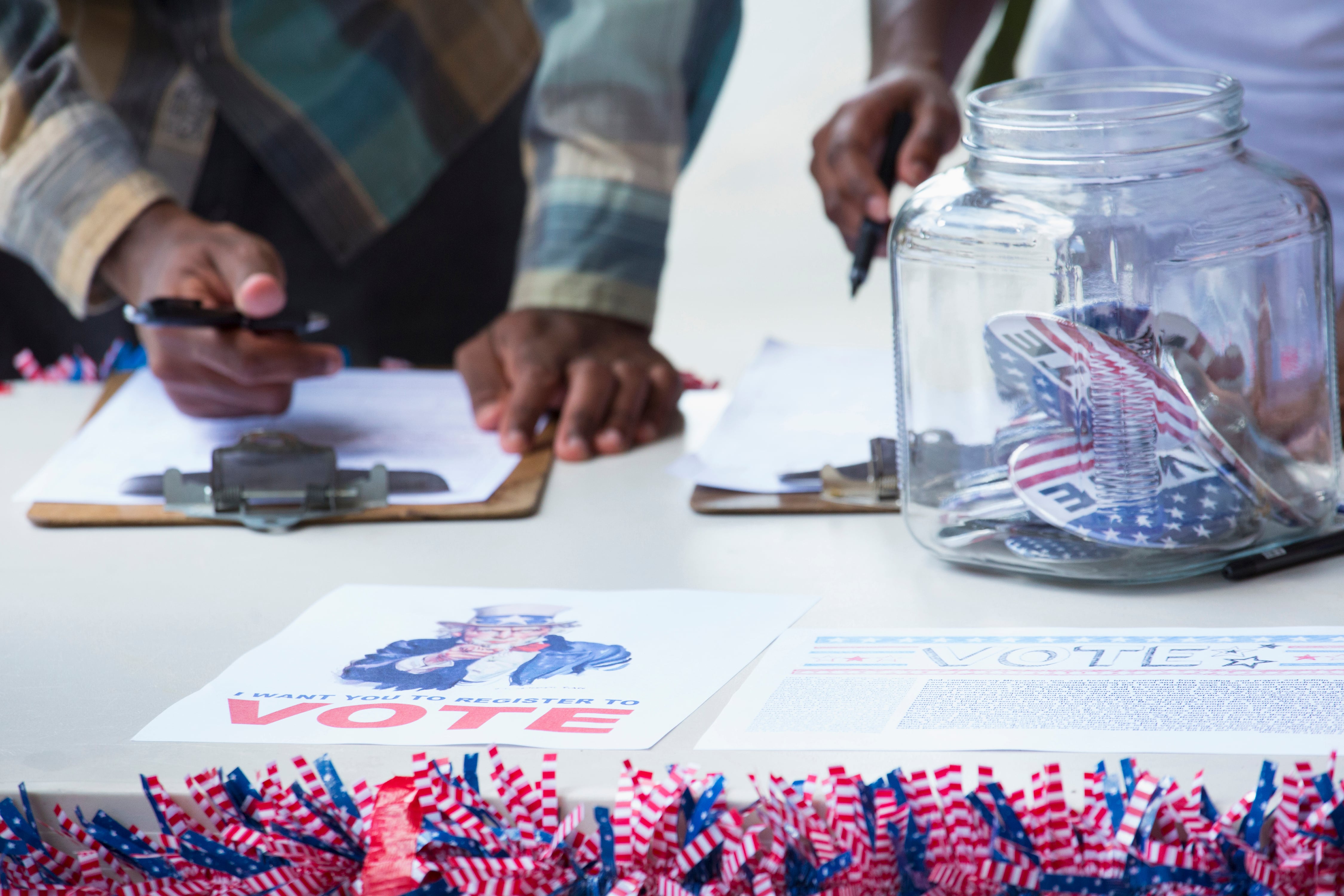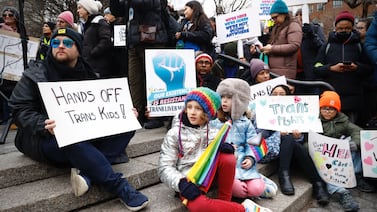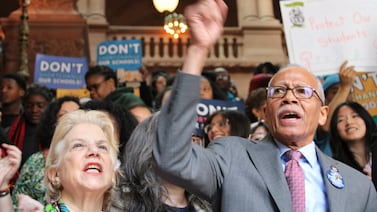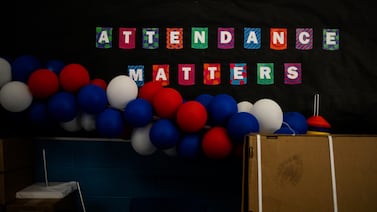Sign up for Chalkbeat Indiana’s free daily newsletter to keep up with Indianapolis Public Schools, Marion County’s township districts, and statewide education news.
In last year’s elections, just five Shortridge High School students cast a ballot.
This year, Sweet Night and Hazel Lapish, both juniors, want to convince more of their peers to vote.
As leaders in the new Shortridge Key Club, they started a voter registration drive ahead of Monday’s registration deadline in Indiana, with a tabling event at their school in September, and a focus on helping students who will be 18 by Election Day on Nov. 5 get registered.
Their efforts are one of a growing number across the state dedicated to increasing youth voter participation in Indiana, especially ahead of a presidential election where the demographic could play a pivotal role in the decision.
And with Indiana’s overall voter turnout ranking nearly last, advocates hope that by encouraging young people to register and vote now, it will become a matter of habit.
Lapish and Night know their peers who are eligible to vote are also busy filling out college applications, focusing on tests, and figuring out their next step. But making time to vote plays a key role in that future, Lapish said.
“They think only old people vote,” Lapish said. “But then we’re building a nation only for old people.”
Recent years have renewed efforts to engage more young voters, said Linda Hanson, president of the Indiana chapter of the League of Women Voters.
In addition to the initiatives led by students themselves, organizations have stepped in to engage more young voters — even those too young to officially vote.
Over 7,000 students in 41 schools are participating in this year’s Kids Election, which is led by 120 classroom teachers with curriculum support from the Indiana Bar Foundation.
The goal is for students who are eligible to actually register to vote, said Chuck Dunlap, president and CEO of the Indiana Bar Foundation, which is hosting the event. Those who aren’t eligible will complete a mock registration. All students in the program will learn about the national and state candidates running for office and cast a ballot, with the results announced after Election Day.
The Bar Foundation took over the administration of the program in 2022, but it has run in past presidential election years; in 2016, students chose Hillary Clinton over Donald Trump.
“If you’re not taught civics and voting at an early age, you don’t carry it with you in adult life,” said Dunlap. “We want to instill the importance of voting and why it matters and build that muscle memory.”
Communicating the importance of voting
It’s not always easy to convince their peers of the importance of voting, Night and Lapish said. Even among those who are interested, the process can be difficult to navigate.
In addition to in-person voter registration, the two juniors also made social media accounts to connect with students.
“They might be intimidated by the voting process,” Night said. “We want to make this easier and more accessible and tell them it’s OK.”
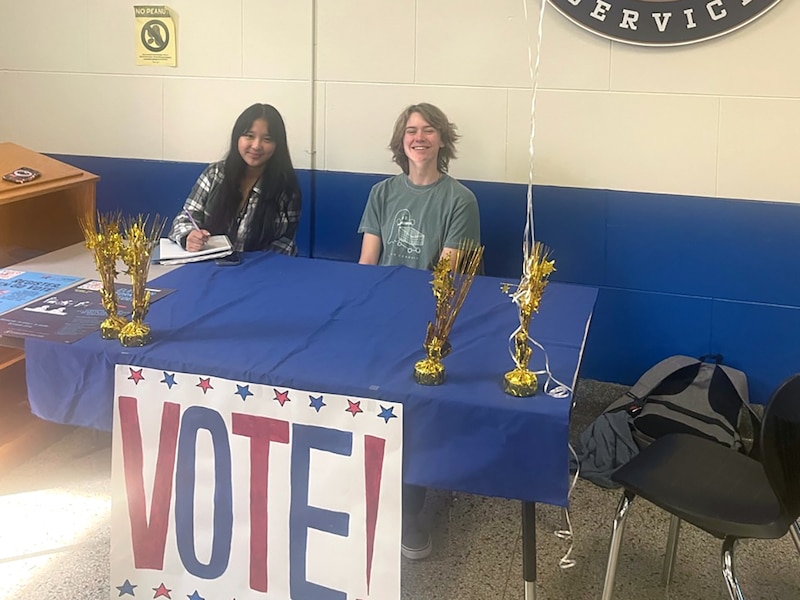
More information can help students clear some of the hurdles to voting, said Hanson of the League of Women Voters. When a college student expressed that he didn’t know where to register to vote — in his hometown or on his campus — Hanson explained how to choose.
Apathy and cynicism can be a challenge among high school and college-aged voters, Hanson said, but she has a strategy to combat it when she visits classrooms.
She passes out character cards with a set of characteristics, such as age, race, and gender, and has students stand up if their character would be allowed to vote at certain points in U.S. history. At the beginning, only a handful can stand up.
It’s a surprise to many that the Constitution does not guarantee a right to vote, Hanson said.
“It does shock them,” Hanson said.
But what she really wants to communicate is that voter suppression is not just a thing of the past, but also a threat to the present and future. So she also covers the impact of limited voting hours and polling places on the ability to vote.
In recent years, Hanson said, especially since the pandemic, there have been renewed efforts to engage more young voters, as well as efforts by students who have taken it upon themselves to do this.
“The goal is to get young people voting and being civically engaged,” Hanson said, “because this is the world they’re going to inhabit, and this is their voice.”
Teaching the election while staying nonpartisan
While voter registration drives target young people who could cast a ballot in this year’s elections, programs like Kids Election are also geared toward getting younger students excited about voting in the future.
Students can start casting ballots in the Kids Election as soon as early voting opens in the state on Oct. 8.
With the real candidates on the ballot, the Bar Foundation’s Dunlap acknowledged that it’s a contentious year to present elections in classrooms.
But in some ways, incorporating real world issues such as the state’s new ban on cell phones during instructional time can help an abstract process become more personal to students, he said.
“If you like it, or didn’t like it, what is your ability to hold someone accountable for that?” Dunap said. “That’s where voting comes in.”
It’s critical to remain nonpartisan while showing students how to find reliable sources of information, said fifth grade teacher Molly Bowman, whose class is participating in the Kids Election. She said she also takes care to point out to her students that they have more than two choices for each office.
Though it’ll be years before her students can actually vote, Bowman said it’s an ideal time for her students to participate in the Kids Election, as they’ve just started their first year of in-depth U.S. history.
Voting makes the electoral process come into focus, she said.
“I encourage them to read, talk to their parents, see what their parents think. I encourage kids to go to the polls with their parents – it makes more sense when you go. It’s hard to explain a poll,” Bowman said. “For the first time in their lives, the things they see in the news about the election process will make sense.”
To register to vote or check your status, go here. Early voting starts Tuesday, Oct. 8.
Aleksandra Appleton covers Indiana education policy and writes about K-12 schools across the state. Contact her at aappleton@chalkbeat.org.

